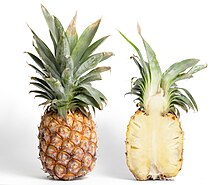Butyric acid ethyl ester
| Structural formula | |||||||||||||||||||
|---|---|---|---|---|---|---|---|---|---|---|---|---|---|---|---|---|---|---|---|

|
|||||||||||||||||||
| General | |||||||||||||||||||
| Surname | Butyric acid ethyl ester | ||||||||||||||||||
| other names |
|
||||||||||||||||||
| Molecular formula | C 6 H 12 O 2 | ||||||||||||||||||
| Brief description |
colorless liquid with a pineapple-like odor |
||||||||||||||||||
| External identifiers / databases | |||||||||||||||||||
|
|||||||||||||||||||
| properties | |||||||||||||||||||
| Molar mass | 116.16 g mol −1 | ||||||||||||||||||
| Physical state |
liquid |
||||||||||||||||||
| density |
0.88 g cm −3 (20 ° C) |
||||||||||||||||||
| Melting point |
−93 ° C |
||||||||||||||||||
| boiling point |
121 ° C |
||||||||||||||||||
| Vapor pressure |
17.5 hPa (20 ° C) |
||||||||||||||||||
| solubility |
poor in water (6.2 g l −1 at 20 ° C) |
||||||||||||||||||
| Refractive index |
1.3930 (18 ° C) |
||||||||||||||||||
| safety instructions | |||||||||||||||||||
|
|||||||||||||||||||
| As far as possible and customary, SI units are used. Unless otherwise noted, the data given apply to standard conditions . Refractive index: Na-D line , 20 ° C | |||||||||||||||||||
Butyric acid ethyl ester is a carboxylic acid ester with a characteristic pineapple odor .
Because of the pronounced aromatic odor, the esters of short-chain carboxylic acids - such as ethyl butyric acid - are also called fruit esters (see also fruit aroma ).
Butyrate is an esterification of butyric acid with ethanol produced. Ethyl butyrate is used as an aroma in perfume production and in beverages, e.g. B. in liqueurs and in orange juice.
properties
The first detailed description of the butyric acid ethyl ester from 1843 mentions the following properties: “It is liquid, colorless, very mobile, very easily flammable and has a pleasant smell which is similar to that of pineapple. It is sparingly soluble in water, but soluble in all proportions in alcohol and methanol . [...] Alkalis, even when heated, only decompose it slowly. "
Occurrence
Butyric acid ethyl ester is not only found in pineapples, but also contributes to the typical aroma of strawberries , apples , peaches and oranges . Together with decanal, it is the most important contribution to the taste of orange juice and is therefore often added to it as a flavoring. Butyric acid ethyl ester is one of the important components of fresh pineapple scent, especially in the Smooth Cayenne variety. But there are also pineapple varieties whose aroma is dominated by other esters.
Individual evidence
- ↑ a b c d e f g h Entry on ethyl butyrate in the GESTIS substance database of the IFA , accessed on February 1, 2016(JavaScript required) .
- ↑ D'Ans Lax: Pocket book for chemists and physicists . Volume II: Organic Compounds . 4th edition Springer, Berlin 1983, ISBN 3-540-12263-X .
- ↑ Carbonyl reactions I, 8.1.2 Ethyl butyrate. (PDF) In: Basic internship in organic chemistry for students of chemistry and food chemistry. University of Hamburg, Department of Chemistry, March 21, 2011, accessed on September 8, 2017 .
- ↑ Théophile-Jules Pelouze , Amédée Gélis: About butyric acid . In: Otto Linné Erdmann, Richard Felix Marchand (Hrsg.): Journal for practical chemistry . tape 29 , no. 1 . Johann Ambrosius Barth, Leipzig 1843, pages 462–463: Der Butteräther, p. 453–465 , doi : 10.1002 / prac.18430290171 ( bsb-muenchen.de - Instead of “ ester ”, the term “ ether ”, which is inappropriate according to today's nomenclature, was used).
- ↑ Théophile-Jules Pelouze, Amédée Gélis: About butyric acid . In: Friedrich Wöhler, Justus Liebig (Ed.): (Justus Liebigs) Annals of Chemistry and Pharmacy . tape 47 , no. 3 . CF Winter, Heidelberg 1843, pages 250-251: Butyric acid ether, p. 241–253 , doi : 10.1002 / jlac.18430470302 ( limited preview in Google Book search).
- ↑ Théophile-Jules Pelouze, Amédée Gélis: Mémoire sur l'acide butyrique . In: J.-B. Dumas (Ed.): Comptes Rendus Hebdomadaires des Séances de l'Académie des Sciences . tape 16 , no. 1 . Bachelier, Paris January 2, 1843, pages 1268–1269 Éther butyrique, p. 1262–1271 ( online at Gallica Bibliothèque numérique ).
- ^ Mette Larsen, Leif Poll: Odor thresholds of some important aroma compounds in strawberries . In: Journal of Food Study and Research . tape 195 , no. 2 , August 1992, p. 120–123 , doi : 10.1007 / BF01201770 : "The most important compounds were ethyl butanoate ..."
- ↑ Stefan Lunkenbein: Mature Correlated enzymes of the secondary metabolism of strawberries (Fragaria x ananassa) . Dissertation, Technical University of Munich. April 2006, p. 7 ( tum.de [PDF; 2.0 MB ; accessed on September 8, 2017]): "Components with the highest aroma values"
- ↑ Cox Orange. (PDF) Retrieved September 8, 2017 .
- ↑ Cindy Lang: Sensors for monitoring the post-harvest behavior of climacteric fruits . Dissertation at the Technical University of Berlin. 2011, p. 10 ( tu-berlin.de [PDF; 2.8 MB ; accessed on September 8, 2017]): "The most important esters include ethyl butyrate"
- ↑ Gerald Rimbach, Jennifer Möhring, Helmut F. Erbersdobler: Food and goods knowledge for beginners . Springer, Berlin 2010, ISBN 978-3-642-04485-4 , 9.6.6 Aromas and Flavors, p. 228 ( google.de ).
- ↑ a b c Liang-Yong Zheng, Guang-Ming Sun, Yu-Ge Liu, Ling-Ling Lv, Wen-Xiu Yang: Aroma Volatile Compounds from Two Fresh Pineapple Varieties in China . In: International Journal of Molecular Sciences . tape 13 , no. 6 , June 14, 2012, p. 7383-7392 , doi : 10.3390 / ijms13067383 ( mdpi.com [accessed September 8, 2017]).
- ↑ Andrea Walker: Ask an Academic: Orange Juice. The New Yorker, May 12, 2009, accessed September 8, 2017 .

